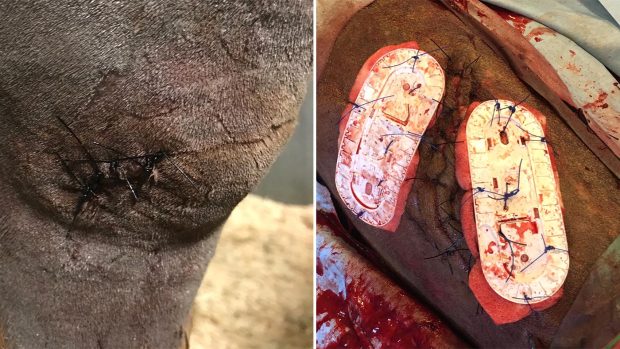Of all the species vets deal with, horses seem especially prone to wounds. And, after colic, wounds are the most common group of emergency conditions in horses.
When we compete horses we present them with unnatural hazards, increasing their potential for injury. Yet the majority of wounds occur at home. It is a sad fact that many horses sustaining fractured limbs from a kick by another horse do so within a few days of being introduced to the new group, while the pecking order is being rearranged.
Dos and don’ts
When to call the vet
When assessing a wound, the first priority is to determine whether veterinary attention is required. Generally speaking, if the wound is less than 8hr old and the edges can be pulled apart, suturing may be of benefit.
Simple skin wounds are not usually very painful. If the degree of lameness is disproportionate to the size of the wound, this may suggest a penetration of a synovial structure, ie a joint, bursa or tendon sheath.
Similarly, if there is an unexpected degree and persistence of lameness where a wound occurs as a result of a kick to a region of the limb that has little flesh overlying the bone, a hairline fracture could be involved. But absence of obvious lameness does not rule out penetration of a synovial structure or bone damage.
Healing
There are many things that influence a wound’s ability to heal. These include the age of the horse, healing ability and the time of year, with conditions associated with the summer months, principally the heat and flies, combining to interfere with healing.
But the two most significant factors are the extent of the blood supply to the region involved and the degree of contamination.
Due to the generally poor circulation in the lower limbs of the horse, wounds in that area tend to be challenging to treat and suturing may be of little help. Limb wounds are also more likely to be contaminated with visible dirt and debris as well as invisible bacteria.
It is pointless to suture an infected wound. The time it takes for the bacterial population to multiply to an unacceptable level ranges from 4-8hr depending on the degree and type of contamination. Unfortunately, failure to close the wound adequately with skin suturing can often result in overzealous healing and the formation of excess granulation tissue or “proud flesh”.
The fundamental approach to treating wounds is to provide the best environment to allow nature time to do what it does best. The wound should be kept moist and sterile while allowing for removal of excess discharge and providing a barrier to external contaminants.
In the early stages this can be achieved through bandaging or the use of a topical treatment. The most commonly prescribed treatment used to be an antibiotic and steroid combination cream. However, after license expiry in May of this year, this is no longer available. Luckily medical and herbal hydrogels are proving to be equally as effective and remain widely available.
Studies have shown that unpasteurised honey also has valid medical benefits in the treatment of wounds. As well as providing a viscous barrier, honey contains some enzymes that promote tissue formation and others that break down into hydrogen peroxide, generating highly reactive free radicals. Renewed interest is being shown in the use of honey, as MRSA, E coli, and other “superbugs” have been shown to be controlled by it where all else has failed.
A new injury will also benefit from being cold-hosed for about 20min at a time, as many times a day as possible. Shorter periods aren’t as beneficial, as they don’t give the blood vessels enough time to react fully. Applying cold temperatures can encourage blood flow and help reduce inflammation.
Other benefits of cold-hosing include cleansing of the wound and relieving pain by acting like a topical analgesic. Purpose-built equine cold water spas have been developed to optimise this treatment approach and are gaining in popularity.
In conclusion, a skin wound wants to heal. There is much that we can do to assist this process by creating the right environment. However, if it is not healing it is either because we have failed to do this or there is some other structure (eg tendon or bone) or tissue involved and further investigation is required.
|
||
 |
||


 Get up to 19 issues FREE
Get up to 19 issues FREE TO SUBSCRIBE
TO SUBSCRIBE 


